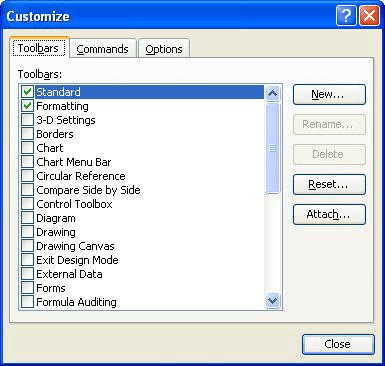Written by Allen Wyatt (last updated August 17, 2024)
This tip applies to Excel 97, 2000, 2002, and 2003
Excel allows you to create your own custom toolbars, as described in other issues of ExcelTips. After your toolbar has outlived its usefulness, you may want to delete it. You cannot delete the built-in toolbars used by Excel, but you can delete ones you previously created. Follow these steps:

Figure 1. The Toolbars tab of the Customize dialog box.
ExcelTips is your source for cost-effective Microsoft Excel training. This tip (2723) applies to Microsoft Excel 97, 2000, 2002, and 2003.

Professional Development Guidance! Four world-class developers offer start-to-finish guidance for building powerful, robust, and secure applications with Excel. The authors show how to consistently make the right design decisions and make the most of Excel's powerful features. Check out Professional Excel Development today!
Ever tried to clean-up the icons on your toolbar only to have one that won't go away? This tip explores some possible ...
Discover MoreExcel allows you to easily customize what appears on its various toolbars. If you make customizations to the Standard ...
Discover MoreWant to get rid of a toolbar button? There's no need to drag open the menus and dialog boxes; just use the shortcut ...
Discover MoreFREE SERVICE: Get tips like this every week in ExcelTips, a free productivity newsletter. Enter your address and click "Subscribe."
There are currently no comments for this tip. (Be the first to leave your comment—just use the simple form above!)
Got a version of Excel that uses the menu interface (Excel 97, Excel 2000, Excel 2002, or Excel 2003)? This site is for you! If you use a later version of Excel, visit our ExcelTips site focusing on the ribbon interface.
FREE SERVICE: Get tips like this every week in ExcelTips, a free productivity newsletter. Enter your address and click "Subscribe."
Copyright © 2025 Sharon Parq Associates, Inc.
Comments